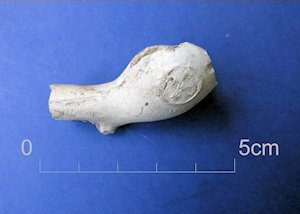
The assemblage is summarised in date order, giving the relevant Bristol Type Series Number (Jarrett 2013, 217-24), where applicable. A full listing and quantification of the clay tobacco pipe, by context, is given in the clay tobacco pipe catalogue.
A significant proportion of the bowl fragments bear makers' marks, and these were identified, where possible, with reference to Jarrett 2013 and Jackson and Price 1974. Further information on the makers was supplied by Price 2014 (see footnotes for this section), and this information is also summarised below, giving details of the working history of each maker and the location of their workshops, where this is known.
Note that, in some cases, pipes were assigned to a pipemaking dynasty, rather than to a specific individual, as several generations of pipemaking families often bore the same first name, as was the case in the Tippett, the Macey and the Carter families (Jarrett 2013, 215 and see below).
The situation is further complicated by the fact that pipe moulds were often handed down through generations of makers, or were passed from one maker to another (Jackson and Price 1974, 86). In terms of identification, the method used was firstly to date each marked pipe fragment diagnostically, by means of bowl form, and after that to refer to the lists of makers known to have been working in Bristol in the given period (as recorded above).
One decorated stem fragment was recovered during the excavation, from Context 1138, showing stylised foliage decoration, raised beading and roundels (see Jarrett 2013, 285). The fragment is of probable late 18th century or later date, as Iain Walker suggests that ornate stem decoration on pipes is rare before c. 1780 (Walker 1971, 21).
Of the small number of pre-1700 examples, it is perhaps significant that four do not fit easily within the recently established typology for Bristol pipes, and may, therefore have been manufactured elsewhere. Only one of these early pipe fragments bears a maker's mark, the initial 'E' or 'F' above a fleur de lys, above a star, and this remains to be identified (see Figure 65), despite extensive search in the published sources. Two further fragments, of later 17th/early 18th century date, may be Gloucestershire products, as they conform more easily to Peacey's Gloucestershire typology, Types 5 and 9 (Peacey 1979, figures 1 and 2). One marked bowl fragment (probably BRST 15), showing the initials, 'IOB' remains similarly unidentified, but is likely to be a Bristol product, as a similar bowl was retrieved during the Cabot Circus excavations (Jarrett 2013, 230, fig. 4.20.32), and many contemporary Bristol makers bore these initials (Jackson and Price 1974, 29-30).

Internet Archaeology is an open access journal based in the Department of Archaeology, University of York. Except where otherwise noted, content from this work may be used under the terms of the Creative Commons Attribution 3.0 (CC BY) Unported licence, which permits unrestricted use, distribution, and reproduction in any medium, provided that attribution to the author(s), the title of the work, the Internet Archaeology journal and the relevant URL/DOI are given.
Terms and Conditions | Legal Statements | Privacy Policy | Cookies Policy | Citing Internet Archaeology
Internet Archaeology content is preserved for the long term with the Archaeology Data Service. Help sustain and support open access publication by donating to our Open Access Archaeology Fund.